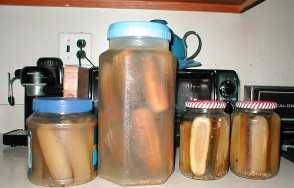
mmmm, mmmm these came out real good.
How to do it
I prepare my salt solution ahead of time so that it can be poured over
the cukes when cold.
Boil about a gallon of water for few minutes to boil off the chlorine,
then take it off the heat.
Take about one quart of that water and dissolve your salt in it.
Allow both the salted and unsalted water to cool to room temp.
Wash the cukes very well--the ends may be trimmed or not, it makes no difference. They may be left whole, or sliced lengthwise in halves, quarters, etc. Sliced cukes will take less time to ferment and become pickles. Wash your container well, then swish some scalding-hot water around inside it. Pour it out and let the container cool down.
Put some of the dill and other seasonings in the bottom of the container,
reserving the remainder for the top**
Pack your cucumbers into the container
Layer on the rest of the herbs and spices
Pour in the cooled salt water, filling remainder of container with the
cooled plain water
put the heel of bread on top
**Depending on the size and shape of your container, you may be arranging the cukes in 1 or more layers. Divide seasonings accordingly - two layers of cukes = three layers seasonings (bottom, middle, top)
IMPORTANT - the cukes must be kept under the brine at all times. Weight them down with something inert, clean and heavy, like a ceramic saucer or a drinking glass that fits into the container opening (no metal). Get the brine level up near the top once the weight is on. Cover the pickle container opening with a clean shower-cap style topper or similar. I have no experience with anything more airtight. This worked fine.
Put the container in a cool dry safe place...you may want to set your
container in a bucket in case it gets bumped and brine sloshes out. Temperature
affects the time needed to ferment. About 70-75 deg. F is best, if that
can be managed. In my experience, whole uncut pickles took:
4 days at 81 deg. F (August)
5 days at 77 deg F (September)
7 days at 66 deg F (October)
(fermenting in the tall container on the left, in the cupboard under the
kitchen sink)
Check them daily, skimming off bubbles and salt scum if it forms. Personally,
I throw moldy stuff out, but people tell me it's ok if skimmed off. You
will need to test them until you can recognize doneness. Slice the pickle
in half and look for somewhat translucent insides all the way through,
the absence of fresh cucumber smell, and a good pickle taste. They may
be a little strong and salty, but you aren't finished yet.
Finishing pickles
When your pickles are translucent inside and taste like pickles, they're ready. Remove the top layer of floating herbs and spices, put on a tight-fitting top, and refrigerate them to stop further fermentation. This is the old-world way -- no vinegar. Personally I like to finish them off with an extra step to reduce the saltiness somewhat and give a little vinegar bite:
Remove bread heel and the bulk of herbs and spices floating on top.
Pour out half the salt brine.
Add about 1/3-1/2 cup white vinegar (per gallon of pickles)
Fill to top with plain tap water
Put on tight-fitting lid
Refrigerate
You will have something close to the modern deli-barrell or Claussen pickle
with this process. I usually make and store them in the same container.
I have found these pickles will store nicely for at least 10 months in
the back of the fridge in a tightly closed container that gets opened
occasionally. Avoid putting fingers in the jar, and use clean wood or
plastic tongs when you remove pickles from the container.
with thanks to sis Margaret and niece Liz Harris for help with the recipe!
Ingredients
Makes a 1-gallon container of pickles
Spice measurements can be varied according to your taste, but never the salt, which must never be reduced. Salt content enables safe fermentation. This recipe produces an old-fashioned deli-style pickle, like the ones you got from a deli barrell, and similar to Claussen or Ba-Tampte brands, maybe a little stronger. For containers, use glass, glazed crockery, or food-grade plastics. Never use metal containers, and never use plastics not intended specifically for food (no buckets, trash bags, trash cans, etc.).
For each gallon:
About 12-18 blemish-free Kirby or "pickling" cucumbers, whatever
can be packed tightly into your gallon container with an inch or more
empty room at the top of the container.
1/2 cup kosher salt or pickling salt (do not use sour salt or salt with
added citric acid. Any salt with anti-caking additives is ok, but will
cloud the brine somewhat. Pickling salt i.e. no additives will not)
Big bunch of fresh dill - about 12-15 full stalks, no roots*
2 tbsp Dill seed*
2-4 medium-large cloves fresh garlic, flattened (err on the side of less,
else you will overwhelm the dill and get musty taste)
2 tbsp Mustard seed
1 tbsp whole black peppercorns
2 large bay leaves
small heel of rye or pumpernickel bread (optional, stale is ok, NO mold
whatsoever)
1 tsp dried hot red pepper or other hot pepper to taste (optional)
*if you can obtain fresh or dried whole dill with flower-heads, omit the dill seed